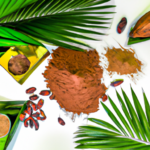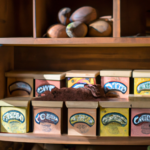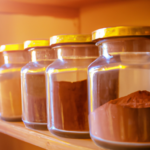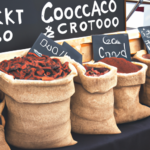Raw Food Ingredients
Where Can I Buy Raw Cacao Powder
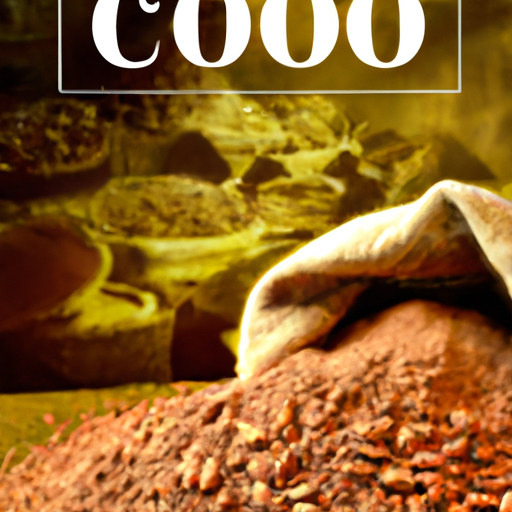
If you are a fan of chocolate like I am, then let me introduce you to the ultimate chocolate discovery: raw cacao powder. Believe me, this is a total game-changer. Filled with antioxidants, vitamins, and minerals, this superfood will make you feel like a superhero.
But here’s the thing, finding raw cacao powder can be a bit of a challenge. Fear not, my fellow chocolate enthusiasts, for I have done the research for you. In this article, I will reveal the secret locations where you can get your hands on this divine ingredient.
From health food stores to online retailers, organic markets to specialty food stores, and even direct from farmers, I’ve got you covered. So, put on your cape and get ready to embark on a chocolate-filled adventure. Let’s find out where you can buy raw cacao powder!
Key Takeaways
- Raw cacao powder can be purchased from local ethnic food stores, which often offer a variety of traditional uses and authentic products.
- Buying directly from farmers allows for freshness, authenticity, and the opportunity to support community agriculture and fair trade practices.
- Artisan bakeries and health-conscious cafes often use high-quality raw cacao powder in their goods and menu items, providing unique flavors and health benefits.
- Online marketplaces offer convenience and a wide selection of raw cacao powder, often at competitive prices, but it is important to consider shipping fees, product authenticity, and quality when purchasing online.
Health Food Stores
You can find raw cacao powder at health food stores, where shelves are lined with an array of organic and wholesome products. Raw cacao powder is a superfood that offers numerous benefits for overall health. It is rich in antioxidants, which help combat free radicals and protect the body from oxidative stress. Additionally, it contains minerals like magnesium, iron, and potassium, which are essential for various bodily functions. Raw cacao powder is also known to boost mood and improve cognitive function due to its content of compounds like phenylethylamine and anandamide.
There are several different ways to incorporate raw cacao powder into your diet. You can add it to smoothies, oatmeal, or yogurt for a rich chocolate flavor. It can also be used in baking, making delicious and nutritious desserts.
Transitioning to the subsequent section about online retailers, you can also purchase raw cacao powder from various online platforms.
Online Retailers
For an easy and convenient shopping experience, check out online retailers like Amazon or Thrive Market for a wide selection of high-quality raw cacao powder. Here are five reasons why you should consider buying raw cacao powder online:
-
Variety: Online retailers offer a vast range of options, including different brands, flavors, and organic options.
-
Convenience: With just a few clicks, you can have raw cacao powder delivered right to your doorstep, saving you time and effort.
-
Reviews: Online platforms provide customer reviews, allowing you to make informed decisions based on others’ experiences.
-
Competitive Prices: Online retailers often offer competitive prices and discounts, allowing you to find the best deals.
-
Recipes and Tips: Many online retailers provide recipes and tips on how to use raw cacao powder in various dishes, making it easier to incorporate into your daily diet.
Now let’s explore another option for purchasing raw cacao powder – organic markets.
Organic Markets
If you’re looking for a more locally sourced option, organic markets are a great place to find high-quality ingredients like raw cacao powder. These markets often prioritize organic farming practices, which means that the cacao powder you find there is likely to be free from harmful pesticides and chemicals.
Additionally, many organic markets also support fair trade, which ensures that the farmers who grow the cacao beans receive fair wages for their work. This means that by purchasing raw cacao powder from these markets, you are not only getting a high-quality product but also supporting sustainable and ethical practices.
Now, let’s move on to the next section about supermarkets, where you can also find raw cacao powder.
Supermarkets
When it comes to shopping for groceries, there are two main types of supermarkets to consider: large chain supermarkets and local supermarkets.
Large chain supermarkets, like Walmart or Costco, offer a wide variety of products at competitive prices. They often have spacious layouts and ample parking, making them convenient for shoppers.
On the other hand, local supermarkets, such as neighborhood grocery stores, may have a more limited selection but often prioritize supporting local farmers and businesses. They can provide a more personalized shopping experience and are often more embedded in the community.
Overall, the choice between large chain supermarkets and local supermarkets depends on individual preferences and priorities.
Large chain supermarkets
Large chain supermarkets provide a convenient option for purchasing raw cacao powder. They typically have a wide variety of other ingredients and products available. If you prefer to explore alternative options, you can also find raw cacao powder at farmers markets and wholesale distributors. Farmers markets are a great place to find locally sourced and organic products, including raw cacao powder. Wholesale distributors may offer larger quantities of raw cacao powder at a discounted price. By considering these alternatives, you can ensure that you are getting the best quality and value for your raw cacao powder.
Now, let’s move on to the next section about local supermarkets.
Local supermarkets
Local supermarkets are a treasure trove of culinary delights, offering a wide array of delectable ingredients and products to satisfy all your cooking needs. When it comes to finding raw cacao powder, these local supermarkets are often a great place to start.
Raw cacao powder is a versatile and nutritious ingredient that can add a rich chocolate flavor to any recipe. It is packed with antioxidants and minerals, making it a great addition to your daily diet. You can incorporate raw cacao powder into your daily routine by adding it to smoothies, oatmeal, or even using it as a substitute for cocoa powder in baking.
With its numerous health benefits and delicious taste, raw cacao powder is a must-have in any kitchen.
Now, let’s explore the next section about co-ops and bulk stores.
Co-ops and Bulk Stores
At co-ops and bulk stores, you’ll find shelves filled with an array of organic products, including raw cacao powder.
Buying raw cacao powder in bulk at these stores has several benefits. First, you can save money by purchasing a larger quantity at a lower price per ounce.
Second, buying in bulk reduces packaging waste, making it an environmentally friendly option.
Lastly, having a stock of raw cacao powder ensures that you never run out and can enjoy its health benefits whenever you want.
To find co-ops and bulk stores near you, you can use online directories or search for local farmer’s markets where these stores often set up booths.
Next, we’ll explore specialty food stores and their offerings.
Specialty Food Stores
When it comes to finding unique and high-quality ingredients, gourmet food stores are my go-to. These stores specialize in offering a wide selection of specialty foods. They have everything from artisanal cheeses to imported oils and vinegars, and even rare spices.
Ethnic food stores are also a treasure trove of ingredients from around the world. They offer a diverse range of spices, sauces, and grains that can bring exciting flavors to your cooking.
Gourmet food stores
Gourmet food stores are a great place to find high-quality and unique ingredients for your cooking and baking needs. These specialty stores often carry a wide range of gourmet ingredients, including raw cacao powder. You can easily find raw cacao powder at gourmet food stores near you.
Raw cacao powder is a key ingredient in many gourmet chocolate recipes. It adds a rich and intense flavor to desserts and beverages. Not only does it enhance the taste of your creations, but it also offers several health benefits. Raw cacao powder is packed with antioxidants, which can help reduce inflammation and improve heart health. It is also a good source of magnesium, iron, and fiber.
Ethnic food stores
Explore the vibrant world of ethnic food stores and uncover an array of tantalizing options to elevate your culinary creations. These stores are a treasure trove of unique ingredients and flavors that can take your cooking to new heights. Here are five reasons why you should visit an ethnic food store for your raw cacao powder needs:
- Wide variety of ethnic food recipes to try out.
- Discover the health benefits of raw cacao powder, such as its antioxidant properties and mood-enhancing effects.
- Find different brands and varieties of raw cacao powder, allowing you to choose the one that suits your taste preferences.
- Connect with different cultures and learn about their traditional uses of raw cacao powder.
- Support local businesses and farmers by purchasing your raw cacao powder from an ethnic food store.
Now, let’s move on to the next section and explore another exciting option: buying raw cacao powder directly from farmers.
Direct from Farmers
To get the freshest and most authentic raw cacao powder, why not consider buying directly from the farmers themselves? This not only ensures the quality of the product but also supports community supported agriculture and fair trade organizations.
Many farmers who grow cacao beans have started selling their raw cacao powder directly to consumers. By purchasing directly from the farmers, you can establish a closer connection with the source of your cacao powder and even learn more about their farming practices.
Additionally, buying directly from farmers often means cutting out the middleman, resulting in lower prices and more sustainable practices.
Once you have your freshly sourced raw cacao powder, you can take it to local bakeries and cafes to create delicious treats.
Local Bakeries and Cafes
When it comes to finding delicious treats made with raw cacao powder, artisan bakeries are a great place to start. These small, locally-owned establishments take pride in creating high-quality, handcrafted baked goods that are sure to satisfy any chocolate lover.
Additionally, health-conscious cafes often incorporate raw cacao powder into their menu items, offering customers a guilt-free way to indulge in their favorite chocolatey treats while still maintaining a balanced lifestyle.
Artisan bakeries
Located in the heart of the city, there’s a charming artisan bakery that’s like a hidden gem for all your baking needs. This bakery not only offers delicious treats but also prides itself on using traditional artisan bakery techniques. From the moment you step inside, the aroma of freshly baked goods fills the air, making it impossible to resist indulging in their delectable creations. One of their specialties is incorporating raw cacao powder into their recipes, creating a unique and rich flavor profile. They understand the importance of flavor pairings with cacao powder and have mastered the art of combining it with ingredients like almonds, coconut, and cherries. It’s truly a haven for those who appreciate the intricate flavors that cacao powder brings to their baked goods. As you leave the artisan bakery, your taste buds satisfied, the next stop on your culinary adventure is the world of health-conscious cafes.
Health-conscious cafes
Step into the world of health-conscious cafes, where you can discover a variety of nourishing options to fuel your body and satisfy your taste buds.
These cafes are not just about serving delicious food; they also prioritize your overall well-being.
One of the popular ingredients you’ll find in these cafes is raw cacao powder. This superfood is packed with antioxidants, minerals, and mood-boosting compounds. It has numerous benefits for your overall well-being, including improved cardiovascular health, enhanced cognitive function, and increased energy levels.
Health-conscious cafes often incorporate raw cacao powder into their menu items, such as smoothies, desserts, and hot beverages. You can experience the goodness of raw cacao powder in these cafes and enjoy its health benefits.
Transitioning to online marketplaces, you’ll find a wide range of options to buy raw cacao powder and continue to incorporate it into your daily routine.
Online Marketplaces
Although there are various online marketplaces to explore, the convenience and wide selection of products make them great options for purchasing raw cacao powder. When it comes to price comparison, online marketplaces often offer competitive prices compared to health food stores. However, it is important to consider additional costs such as shipping fees. To ensure the authenticity and quality of raw cacao powder purchased from online retailers, there are a few steps you can take. First, read customer reviews and ratings to gauge the experiences of previous buyers. Second, check if the online marketplace has a return policy in case the product does not meet your expectations. Lastly, look for certifications or labels that indicate the cacao powder is organic, fair trade, or sustainably sourced. By taking these precautions, you can confidently purchase raw cacao powder from online marketplaces.
| Pros | Cons |
|---|---|
| Wide selection of products | Additional shipping fees |
| Competitive prices | Potential for counterfeit products |
| Customer reviews and ratings | Lack of physical inspection before purchase |
Frequently Asked Questions
What are the health benefits of consuming raw cacao powder?
Consuming raw cacao powder has numerous health benefits. It is rich in antioxidants, promotes heart health, boosts mood and energy, and improves brain function. Raw cacao powder is different from cocoa powder in terms of processing and nutritional content. Try incorporating it into various recipes for a healthy twist.
Are there any potential side effects or risks associated with consuming raw cacao powder?
Consuming raw cacao powder is generally safe, but like anything, moderation is key. Potential risks include caffeine sensitivity, allergies, and interactions with certain medications. It’s important to follow dosage recommendations and consult a healthcare professional if needed.
How should I store raw cacao powder to ensure its freshness and quality?
To ensure the freshness and quality of raw cacao powder, it should be stored in an airtight container in a cool, dark place. Properly stored, it can have a shelf life of up to two years.
Can I use raw cacao powder as a substitute for regular cocoa powder in baking recipes?
Yes, you can use raw cacao powder as a substitute for regular cocoa powder in baking recipes. It provides a rich, intense flavor. Just keep in mind that raw cacao powder is less processed and might be slightly more bitter. Experiment and adjust accordingly. Baking tips: Start by using the same amount of raw cacao powder as the recipe calls for cocoa powder. Taste the batter and adjust the sweetness if needed.
Are there any specific brands or varieties of raw cacao powder that are recommended for their taste or quality?
Some of the best raw cacao powder brands include Navitas Organics, Terrasoul Superfoods, and Healthworks. To use raw cacao powder in smoothies, simply add a tablespoon to your favorite recipe for a rich and chocolatey flavor.
Is Raw Cacao Powder Available in Local Grocery Stores?
Yes, raw cacao powder is readily available in local grocery stores. Many raw cacao powder suppliers offer their products in the organic or health food section of most grocery stores. Consumers can easily find and purchase raw cacao powder for their cooking and baking needs.
Conclusion
In conclusion, there are numerous places where one can purchase raw cacao powder. Some viable options include health food stores, online retailers, organic markets, supermarkets, co-ops, bulk stores, specialty food stores, and even direct from farmers. Additionally, some local bakeries and cafes may also offer this delectable ingredient. Whether you choose to indulge in its rich flavor or reap its health benefits, the world of cacao powder is at your fingertips.
So go ahead, embrace the bittersweet symphony of raw cacao and elevate your culinary creations to new heights!
Rachael, the Editor in Chief of RachaelsRawFood.com, is an inspiring and passionate individual who has dedicated her life to promoting the benefits of a raw food lifestyle. Known for her vibrant and energetic personality, Rachael has built a strong online presence that has transformed her personal journey into a thriving community of raw food enthusiasts.
Raw Food Ingredients
How Much Caffeine in Cocoa?
Not all cocoa products are created equal when it comes to caffeine content – discover which one might surprise you!

When evaluating the caffeine levels in cocoa, it’s important to recognize that dark chocolate contains around 43 mg of caffeine per 100 grams due to its high cocoa solid content. Dark chocolate has a higher caffeine content compared to milk or white chocolate. This means that consuming dark chocolate in moderation can assist in managing your caffeine intake. On the other hand, milk chocolate has around 20 mg of caffeine per 100 grams while white chocolate is caffeine-free. Cocoa powder, commonly used in baking and beverages, contains a substantial 230 mg of caffeine per 100 grams. Being aware of these distinctions in chocolates can help you make informed decisions about your caffeine consumption.
Key Takeaways
- Caffeine content in cocoa varies based on cocoa solid concentrations.
- Unsweetened cocoa powder can contain around 230 mg of caffeine per 100 grams.
- Roasting cocoa solids influences the final caffeine content in cocoa products.
- Dark chocolate, with high cocoa solid content, has more caffeine than milk chocolate.
- Moderate consumption of cocoa products helps manage caffeine intake.
Caffeine Content in Dark Chocolate
Dark chocolate boasts a caffeine content of approximately 43 mg per 100 grams, mainly deriving from its higher cocoa solid composition. When we indulge in this decadent treat, we aren't only savoring its rich cocoa flavor but also a subtle caffeine kick. Compared to milk or white chocolate, dark chocolate contains a higher amount of caffeine.
Please bear in mind that moderate consumption of dark chocolate can assist individuals in managing their caffeine intake effectively. The caffeine levels in dark chocolate are about one-fourth of what you'd find in a standard cup of coffee. So, if you're looking for a milder caffeine boost, a piece of dark chocolate might just do the trick without the jitters that sometimes accompany a strong cup of coffee.
Enjoy your dark chocolate in moderation, savoring both its taste and the gentle pick-me-up it provides.
Caffeine Levels in Milk Chocolate

Milk chocolate, known for its creamy texture and sweet flavor, contains a modest caffeine content of approximately 5.6 mg per ounce, as indicated by USDA data. Unlike dark chocolate, milk chocolate has a lighter color due to lower cocoa content, resulting in reduced caffeine levels.
The delightful creamy taste in milk chocolate comes from a harmonious blend of cocoa and milk powder. While dark chocolate boasts higher caffeine content, milk chocolate remains a popular choice for those seeking a sweet treat with minimal caffeine intake.
Caffeine Presence in White Chocolate
With its unique composition excluding cocoa solids, white chocolate stands out as a caffeine-free alternative to its darker counterparts. White chocolate is crafted from a blend of cocoa butter, milk powder, sugar, and vanilla, making it a delectable treat without the stimulating effects of caffeine. For individuals sensitive to caffeine, white chocolate offers a creamy texture and indulgent flavor without the worry of unwanted side effects. This makes it a popular choice for desserts among those looking to steer clear of caffeine in their sweet treats.
Compared to dark chocolate, which contains cocoa solids and hence caffeine, white chocolate provides a caffeine-free option for those seeking a more mellow indulgence. So, if you're in the mood for a luscious and smooth chocolate experience without the buzz of caffeine, white chocolate is the perfect choice for your next dessert delight.
Impact of Cocoa Solids on Caffeine

In determining the caffeine levels in cocoa products, the percentage of cocoa solids plays a significant role. Here are some key points about the impact of cocoa solids on caffeine content:
- Caffeine Derivation: The caffeine content in cocoa primarily comes from cocoa solids, making it an important factor in determining the overall caffeine levels in cocoa-based products.
- Dark Chocolate: Dark chocolate, known for its higher cocoa solid content, tends to contain more caffeine compared to milk or white chocolate varieties due to this higher concentration.
- Unsweetened Cocoa Powder: A 100g serving of unsweetened cocoa powder can contain around 230mg of caffeine, reflecting the impact of the high cocoa solid content in this form.
- Health Benefits: The roasting process of cocoa solids not only affects the flavor profile but also influences the caffeine content, contributing to the potential health benefits associated with consuming cocoa products like hot cocoa.
Comparing Caffeine in Different Chocolates
Comparing the caffeine content in different chocolates reveals varying levels based on their cocoa solid concentrations. Dark chocolate contains about 43 mg of caffeine per 100 grams, making it a stronger caffeinated option compared to milk chocolate, which only has around 20 mg per 100 grams.
Surprisingly, white chocolate, derived from cocoa butter, doesn't contain any caffeine at all. For those seeking a more potent caffeine kick, cocoa powder is the way to go, boasting a high concentration of 230 mg per 100 grams.
The amount of caffeine in chocolate products is closely linked to the cocoa solid content, with dark chocolate containing the highest levels. So, the next time you're craving a chocolate treat but also need a little energy boost, opt for dark chocolate to get the most caffeine per bite.
Frequently Asked Questions
Is There More Caffeine in Cocoa Than Coffee?
There's more caffeine in cocoa than in coffee. Cocoa powder packs 230 mg per 100 grams, surpassing most coffee varieties. Dark chocolate has even more caffeine due to higher cocoa content. It's a rich, unique energy source.
Is There a Lot of Caffeine in Hot Cocoa?
There isn't a lot of caffeine in hot cocoa. It depends on the brand and recipe. Starbucks hot chocolate has around 25 mg per serving, while basic mixes have about 5 mg. The amount of cocoa powder used influences the caffeine content.
Is There Caffeine in Hershey's Cocoa?
Absolutely, Hershey's Cocoa does contain caffeine, but it's not overwhelming. It adds a delightful hint of energy in each spoonful. Perfect for baking or a cozy cup of hot chocolate. Just the right amount!
Is Cocoa a Stimulant Like Caffeine?
Cocoa stimulates like caffeine due to its theobromine content. Decaf versions offer a solution for caffeine-sensitive folks. Options include regular cocoa with caffeine, Dutch-processed cocoa with less, and decaf cocoa with reduced caffeine while keeping healthful compounds.
What are the potential health effects of consuming high levels of caffeine in cocoa?
Unveiling cocoa caffeine levels can lead to potential health effects of excessive consumption. High levels of caffeine in cocoa may contribute to insomnia, nervousness, and fast heartbeat. It can also cause gastrointestinal discomfort and exacerbate anxiety disorders. Moderation in consuming caffeinated cocoa products is recommended for overall health.
Conclusion
To sum up, the caffeine content in cocoa varies depending on the type of chocolate. Dark chocolate typically has the highest caffeine levels, followed by milk chocolate and white chocolate. The amount of cocoa solids in the chocolate also affects the caffeine content.
Remember, just like different chocolates have different levels of caffeine, we all have unique strengths and abilities. Embrace your individuality and always aim for balance in everything you do.
Rachael, the Editor in Chief of RachaelsRawFood.com, is an inspiring and passionate individual who has dedicated her life to promoting the benefits of a raw food lifestyle. Known for her vibrant and energetic personality, Rachael has built a strong online presence that has transformed her personal journey into a thriving community of raw food enthusiasts.
Raw Food Ingredients
5 Key Differences: Caffeine Content in Cocoa Vs Coffee
Open the door to understanding the contrasting caffeine levels in cocoa and coffee, revealing surprising insights that will reshape your beverage choices.

When comparing the caffeine levels in cocoa and coffee, it is important to understand that cocoa generally has lower caffeine content than coffee. Dark chocolate contains approximately 12 milligrams of caffeine per ounce, while hot cocoa typically ranges from 5 to 10 milligrams per ounce. In contrast, brewed coffee can have significantly higher levels, varying from 95 to 165 milligrams per 8-ounce cup.
Cocoa is considered a milder option for individuals aiming to limit their caffeine intake, with theobromine providing a gradual energy increase. Meanwhile, coffee's caffeine content offers immediate alertness, and understanding these distinctions can help you select based on your preferred effects.
Key Takeaways
- Cocoa contains lower caffeine levels but compensates with theobromine for a gradual energy increase.
- Coffee has higher caffeine content, offering an immediate alertness boost and potentially higher metabolic rate.
- Theobromine in cocoa promotes relaxation, while caffeine in coffee provides intense alertness and mood fluctuations.
- Hot chocolate is a good option for reducing caffeine intake while still benefiting from theobromine effects.
- Understanding caffeine variances helps make informed choices for desired energy levels and mood effects.
Caffeine Levels in Cocoa Vs Coffee
When comparing caffeine levels in cocoa versus coffee, it's evident that cocoa generally contains lower amounts per serving. Dark chocolate, made from cacao beans, contains around 12 milligrams of caffeine per ounce, while a 1-ounce serving of hot cocoa mix typically has 5-10 milligrams. Even a 16-ounce serving of Starbucks hot chocolate only contains about 25 milligrams of caffeine.
On the other hand, coffee, when brewed, can range from 95 to 165 milligrams of caffeine per 8-ounce cup, depending on the type and brewing method. This significant difference in caffeine content between cocoa and coffee makes cocoa a milder option for those looking to limit their caffeine intake.
Impact on Alertness and Energy

Typically, the immediate alertness and energy boost from caffeine in coffee can last for hours. This surge in alertness is due to caffeine's stimulating effect on the central nervous system. On the other hand, cocoa contains theobromine, which provides a more gradual increase in energy levels. Unlike caffeine, theobromine doesn't cause sudden spikes and crashes, offering a smoother energy curve.
Coffee's caffeine content can temporarily boost the metabolic rate, potentially supporting weight management efforts. This increased metabolic rate can aid in burning calories and may contribute to weight loss when combined with a balanced diet and regular exercise. Additionally, theobromine in cocoa contributes to the thermogenic effect, leading to mild calorie burning in the body.
Both caffeine and theobromine can influence mood. Caffeine tends to provide a more intense and quick-acting mood elevation, while theobromine promotes feelings of relaxation and contentment. Understanding the differences in alertness, energy, metabolic effects, and mood enhancements between cocoa and coffee can help individuals make informed choices based on their preferences and wellness goals.
Metabolic Variances and Effects
Regarding metabolic variances and effects, the varying caffeine levels between cocoa and coffee play a significant role. When comparing the metabolic impact of caffeine in cocoa and coffee, it is crucial to note that cocoa contains lower levels of caffeine but compensates with theobromine, which aids in the thermogenic effect, promoting calorie burning and metabolic activity. On the other hand, coffee, especially brewed varieties, contains higher levels of caffeine, potentially providing a temporary boost to the metabolic rate, which could assist in weight management. While caffeine in coffee offers a quick energy surge, theobromine in cocoa leads to a more gradual rise in energy levels, avoiding sudden spikes and crashes. To summarize the metabolic differences, I've created a table below:
| Aspect | Cocoa | Coffee |
|---|---|---|
| Caffeine Content | Lower levels | Higher levels |
| Additional Component | Theobromine | Caffeine |
| Metabolic Impact | Thermogenic effect | Temporary metabolic rate boost |
| Energy Levels | Gradual rise | Quick surge |
| Weight Management | Aids in calorie burning | Potential assistance |
Mood Enhancement Disparities

In comparing the mood enhancement effects of theobromine in cocoa and caffeine in coffee, notable disparities emerge in their impact on mental well-being.
The theobromine found in cocoa promotes relaxation and contentment, offering a gradual rise in energy levels that leads to a gentle and long-lasting mood enhancement experience.
On the other hand, caffeine delivers an intense and fast-acting boost in alertness, providing immediate energy levels that can lead to abrupt spikes and crashes.
While both theobromine and caffeine uplift mood, theobromine's effects are characterized by a steady and gradual increase in energy levels, creating a sense of calm and contentment.
In contrast, caffeine's impact is more intense and temporary, resulting in rapid alertness but also the potential for fluctuations in mood. Understanding these differences can help individuals choose between cocoa and coffee based on their desired mood enhancement effects.
Health Implications and Considerations
Health implications and considerations surrounding caffeine consumption warrant close attention due to its potential impact on various aspects of well-being. When comparing a cup of coffee to hot chocolate, it's vital to note the amount of caffeine present.
While coffee contains much caffeine, hot chocolate has less caffeine but isn't entirely devoid of it. The main active ingredients in hot chocolate are theobromine and caffeine, where theobromine is a relative of caffeine and also has stimulant effects, although milder. If you're looking to reduce your caffeine intake, opting for hot chocolate over a cup of coffee can be a good choice.
Being mindful of the caffeine content in chocolate products is important, especially if you're sensitive to caffeine or belong to vulnerable populations like children or pregnant women. Understanding the caffeine levels in different beverages allows you to make informed decisions about your consumption for better overall health.
Frequently Asked Questions
Is There Caffeine in Coffee Vs Cacao Powder?
Yes, there is caffeine in coffee, with around 140 milligrams in a 12-ounce cup. On the other hand, cacao powder contains only about 12 milligrams per tablespoon, making it a great caffeine-free alternative for those seeking a milder boost.
What Is the Difference Between Cocoa and Coffee?
When comparing cocoa and coffee, cocoa offers a rich, chocolatey flavor and is packed with antioxidants and minerals. Coffee, on the other hand, provides a robust, bitter taste and a jolt of caffeine for that morning pick-me-up.
Why Is Cocoa Better Than Coffee?
I believe cocoa is superior to coffee because it offers a gentler energy boost, promotes relaxation and contentment, and provides sustained vitality without sudden crashes. Plus, dark chocolate's theobromine supports cellular health and tastes delicious.
How Much Caffeine Is in Cocoa Powder Vs Decaf Coffee?
In cocoa powder vs decaf coffee, cocoa has 12-26mg of caffeine per tbsp, while decaf coffee holds 2-5mg per 8-ounce cup. The choice hinges on desired caffeine levels and flavor. I prefer cocoa's lower caffeine content.
How does the caffeine content in hot chocolate compare to coffee?
Hot chocolate caffeine content is significantly lower than that of coffee. While an 8-ounce cup of hot chocolate contains about 5-10 milligrams of caffeine, the same size of coffee can have anywhere from 95-200 milligrams. It’s a notable difference for those looking to limit their caffeine intake.
Conclusion
To sum up, while cocoa and coffee both contain caffeine, the levels vary significantly. Cocoa generally has lower caffeine content compared to coffee, impacting alertness, energy levels, and mood enhancement differently.
It's crucial to keep these differences in mind when choosing between the two beverages for your daily consumption. Remember, moderation is key to maintaining a healthy balance in your caffeine intake.
So, whether you prefer a cup of cocoa or a mug of coffee, enjoy it in moderation for the best benefits!
Rachael, the Editor in Chief of RachaelsRawFood.com, is an inspiring and passionate individual who has dedicated her life to promoting the benefits of a raw food lifestyle. Known for her vibrant and energetic personality, Rachael has built a strong online presence that has transformed her personal journey into a thriving community of raw food enthusiasts.
Raw Food Ingredients
A Guide to Becoming a Good King
Kingship demands wisdom, fairness, integrity, courage, and humility – essential traits for a successful reign and prosperous kingdom." Keep reading to uncover the secrets of becoming a good king.

In order to be a good king, one must embody wisdom, fairness, integrity, courage, and humility to lead the kingdom with honor. Wisdom is essential for making important decisions, fairness ensures just treatment for all, integrity builds trust and respect, courage is crucial for facing challenges, and humility reminds us of our humanity. Historical kings such as Solomon, Arthur, David, Charlemagne, and Ramses II serve as role models for these leadership traits.
As a king, embracing challenges, understanding the world, seeking personal growth, and learning from the past are essential responsibilities. Developing leadership skills, making wise decisions, and prioritizing the well-being of the people are key to effective kingship. Every step on the path to becoming a good king is critical for a successful reign and prosperous kingdom.
Key Takeaways
- Embrace wisdom for informed decisions.
- Practice fairness for just treatment.
- Uphold integrity to earn trust.
- Show courage in facing challenges.
- Maintain humility for empathy and respect.
Qualities of a Good King
Being a good king requires embodying qualities such as wisdom, fairness, integrity, courage, humility, and compassion in decision-making and leadership. Power comes with responsibility, and as a king, it's essential to wield this power wisely. Wisdom is vital in making sound judgments that benefit the kingdom as a whole. Fairness guarantees that all subjects are treated justly and equitably, fostering a harmonious society. Integrity is the foundation of trust and respect, key elements in effective leadership.
Courage is necessary to face challenges and make difficult decisions, even when met with opposition. Humility reminds a king of his humanity and the importance of humility in interactions with all subjects. Compassion demonstrates a king's care and empathy towards his people, fostering a sense of unity and loyalty. Effective communication is crucial for conveying decisions, listening to concerns, and inspiring confidence in leadership.
Historical Kings as Role Models

King Solomon, renowned for his wisdom and leadership, stands as an exemplar among historical kings who serve as role models for future leaders. Looking at figures like King Arthur, known for his justice and valor in medieval legends, and King David, celebrated for his faith and courage in battle, we find lessons that transcend time. Charlemagne's legacy of military conquests and cultural revival, alongside Ramses II's grand building projects and military campaigns, offer diverse insights into effective kingship. Below is a table summarizing key attributes of these historical kings:
| King | Attributes |
|---|---|
| King Solomon | Wisdom, leadership |
| King Arthur | Justice, valor |
| King David | Faith, courage |
| Charlemagne | Military prowess, culture revival |
| Ramses II | Building projects, military campaigns |
Studying these historical figures can provide valuable lessons on the multifaceted qualities that make a great ruler.
Responsibilities of Kingship
Embracing challenges and living authentically are central to fulfilling the responsibilities inherent in kingship. As men aspiring to be good kings, it's essential for us to understand that the world requires leaders who are kind, humble, and committed to personal growth.
The journey to becoming a good king involves more than just wielding power and responsibility—it entails sacrificing comfort for growth and transformation. Seeking the ancient path of masculinity, as exemplified by figures like Morgan, teaches us the importance of humility, vulnerability, and character development.
In fulfilling the responsibilities of kingship, we're entrusted with power not for our own gain, but for the betterment of the world around us. Just as seeds need Good Soil to flourish, we must nurture our own growth to lead effectively.
Leadership Skills for Kings

Developing essential leadership skills is crucial for aspiring kings seeking to fulfill their responsibilities with humility, vulnerability, and a focus on character development. As you study the world around us, the power and responsibility of what kingship entails become clearer. Here are some key points to think about on your path to becoming a king:
- Embrace challenges and live authentically.
- Seek ancient paths of masculinity for guidance.
- Reflect on your identity, purpose, and ability to be entrusted with power for good.
- Sacrifice comfort for growth, transformation, and participation in universal creativity.
The journey of becoming a king isn't just about gaining authority but about understanding the remarkable fellowship of like-hearted individuals who share similar goals. Engage in group discussion questions, consider between-session personal study, and explore the depths of your masculine soul. This is the path to restoring what it means to be a true king.
Importance of Wise Decision-Making
Steering through the intricacies of leadership, especially in the domain of kingship, requires a sharp focus on the art of prudent decision-making. Wise decision-making is like the compass guiding the ship of leadership towards success.
Good kings understand that their choices impact not just themselves but also the lives of those they rule over. They prioritize the well-being of their people over personal gains, embodying the essence of true leadership.
Seeking counsel from trusted advisors and reflecting on core values are essential practices in the domain of wise decision-making. By embracing humility and self-awareness, kings can navigate the complex web of choices with clarity and integrity.
Just like a six-session video Bible study can guide individuals in restoring the heart, wise decision-making is essential for becoming the kind of leaders our world needs. Let's start on this journey of radical reconstruction, where every decision is a step towards being counted among the good kings of history.
Frequently Asked Questions
What Is the Becoming a King Guide?
The Becoming a King guide is a transformative resource created by Morgan Snyder to help men grow into responsible kings. It offers practical tools and profound insights to aid personal development and transformation.
What Are the Qualities of a Good King?
Being a good king means embodying humility, wisdom, and integrity. Prioritizing the well-being of my people, making decisions for the greater good, and showing courage, justice, and compassion in all actions. Seeking counsel and valuing diverse perspectives is essential.
What Makes a True King?
Beneath the crown lies a heart that beats with humility and a spirit that soars with honor. True kings are forged in the fires of challenge, embracing authenticity and growth to inspire others.
What Makes a Real King?
Being a true king means embodying humility, courage, and empathy. It's about serving others and leading with integrity. I endeavor to cultivate these qualities daily, embracing challenges and seeking growth in all aspects of my life.
How Can Sacred Cacao be Incorporated Into Kingship Rituals?
In kingship rituals, the sacred cacao ritual holds great significance. The ceremonial drinking of cacao symbolizes the divine connection between the ruler and the spiritual realm. It is believed to impart wisdom and strength, making it a crucial element in the coronation and leadership rites of many cultures.
Conclusion
To sum up, becoming a good king requires a combination of qualities, skills, and responsibilities. Remember, 'With great power comes great responsibility.'
By studying historical kings as role models, practicing leadership skills, and making wise decisions, one can aspire to be a just and effective ruler.
It's a challenging path, but with dedication and perseverance, anyone can endeavor to be a worthy leader for their kingdom.
Rachael, the Editor in Chief of RachaelsRawFood.com, is an inspiring and passionate individual who has dedicated her life to promoting the benefits of a raw food lifestyle. Known for her vibrant and energetic personality, Rachael has built a strong online presence that has transformed her personal journey into a thriving community of raw food enthusiasts.
-

 Raw Food Ingredients2 months ago
Raw Food Ingredients2 months agoHow To Make Hot Chocolate With Raw Cacao Powder
-

 Raw Food Ingredients2 months ago
Raw Food Ingredients2 months agoHow To Make Chocolate From Raw Cacao
-

 What is Raw Food?2 weeks ago
What is Raw Food?2 weeks agoHow To Remove Raw Mustard Oil Smell From Cooked Food
-

 Raw Food Ingredients4 weeks ago
Raw Food Ingredients4 weeks agoRaw Cacao Powder How Much For 8 Oz Hot Chocolate Recipe
-

 Raw Food Ingredients4 weeks ago
Raw Food Ingredients4 weeks agoThe Truth Behind the Cacao Caffeine Myth
-

 Raw Food Ingredients2 months ago
Raw Food Ingredients2 months agoWhen Fasting Can I Drink Coffee With Raw Cacao Powder
-

 What is Raw Food?2 weeks ago
What is Raw Food?2 weeks agoHow To Store Raw And Cooked Food Separately
-

 Raw Food Ingredients2 months ago
Raw Food Ingredients2 months agoHow To Use Raw Cacao Beans






